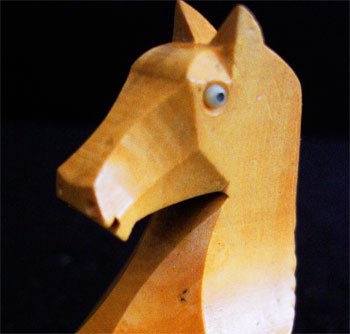knight’s move…

It occurs to me that the moves in chess have interesting parallels to human thought and even to our lives…
A rook represents an orthogonal approach – powerful and direct – but inflexible. A bishop has – literally – an oblique approach, with an ability to slice forensically past seemingly solid opposition. A pawn’s slow, forward plodding – with its frail hope of, in the end, overcoming almost insurmountable odds and reaching that butterfly like transformation at the end of the board – seems to me sadly indicative of so much of the human condition. The king, pityfully hemmed in, vulnerable, lives in a world where everyone IS out to get him. The queen, celebrity, high achiever, struggles to fulfil unreasonable expectations. And, finally, our knight, that paragon of left-field thinking, challenging others when he cannot be challenged himself; leaping over difficulties as if they were not there; arriving at his target by an idiosyncratic route. He’s the one I want to emulate…
My former chess teacher, who’s now just a friend, designed 2 new chess pieces: the hawk and the elephant. He did it because chess (at least in the higher levels) has grown rather stagnant as there are only mathematically so many good openings & moves.
The hawk and the elephant are combination pieces and can be added in at a turn rather than beginning on the original chess board. I believe one of them is a knight + all directions for one square, and the other is a rook & something else. I’ll ask him again.
What do you make of those personalities?
By the way – if you prefer Go, have you read Deleuze & Guattari’s ‘The War Machine: Nomadology’? I think just the first few pages it describes quite beautifully the differences between chess and go (at least on a philosophical level). What you’ve said about the two games seems similar. ^^
I couldn’t agree more with your chess teacher. I lost interest in the game because I was never interested in learning openings. As a consequence I found myself inventing feeble counters to play that was, essentially, that of Grand Masters come back from the dead.
I have explored quite a number of chess variants – of which there are myriads. Of special note would be Glinski’s hexagonal chess – which rejoices in having bishops of not two, but three colours! It has occurred to me that a simpler way to proceed would be to swap the knights and bishops in standard chess. This means that you can play the game with the usual equipment and with a full understanding of the pieces and of much of the positional play. The openings, however, are entirely fresh and new…
What your teacher proposes – the addition of new pieces – has been done frequently. In fact there is a version that sounds very similar. And then of course there were the ancient versions of ‘Grand Chess‘ that rejoiced in not only elephants, but camels and giraffes too!
As for what I make of your teacher’s new pieces – I would say of his knight variant that he is intermittently left-field and humdrum… so he’s probably a much better example of the creative thinker *grin*
I have tangled with Monsieurs Deleuze & Guattari and, though they fascinate me, they make my brain sore – as do so many French philosophers. I shall certainly try and follow this up (as I did your Zhuangzi) as I would like to read this introduction… And, incidentally, I do much enjoy playing Xiangqi – Chinese chess – that makes standard (European) chess seem rather stodgy…
Also, did I ever e-mail you my badly-sketched idea for a Stone Dance chess set? I mean, if there can be a Simpsons-themed chess set, Stone Dance is certainly a worthy subject, with rich thematic possibilities!
no, you didn’t – it’s a fascinating idea… I can imagine that it could work very well indeed…
That’s very interesting; I never thought about it as symbolic of human personality types…
Clearly, I need to play chess with you one day. 🙂
I hadn’t thought about it until I did 🙂 – happy to play chess, though these days I prefer go…